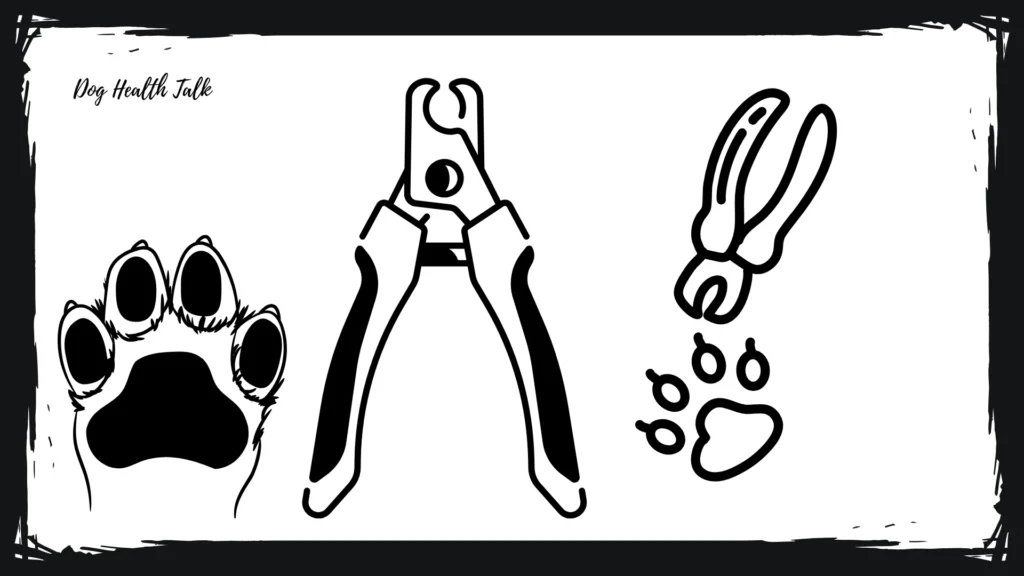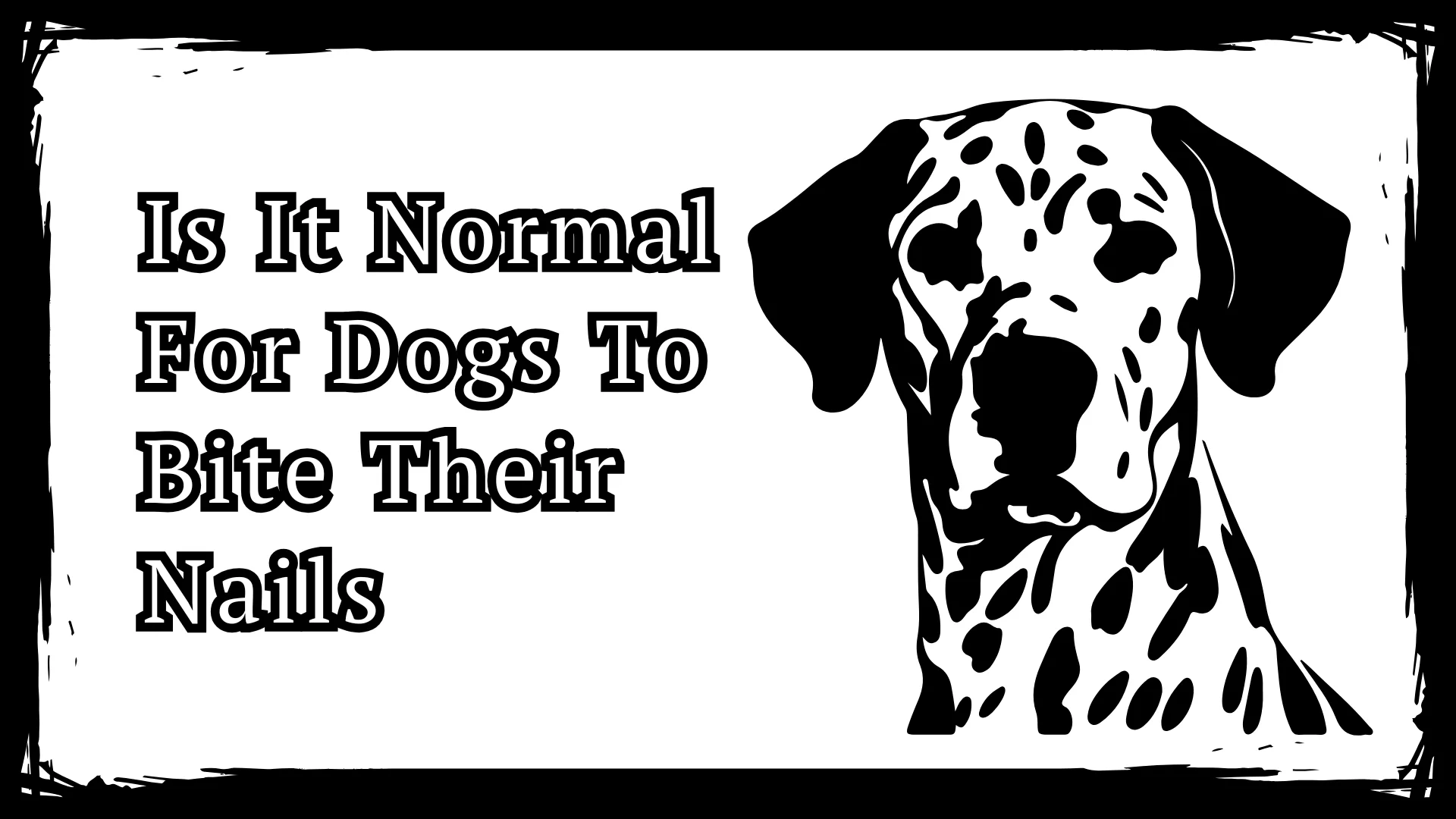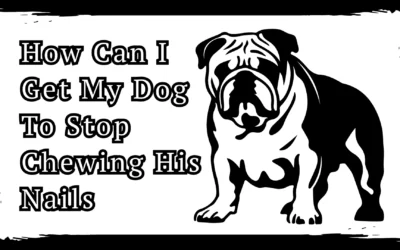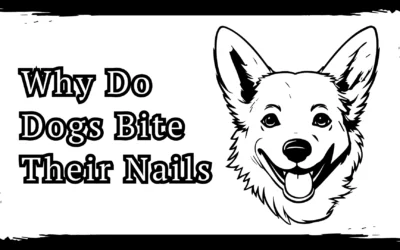Is it normal for dogs to bite their nails? This common question concerns many pet owners who notice their furry companions nibbling at their paws.
Is it normal for dogs to bite their nails? While dogs do not typically bite their nails like humans do, occasional gentle nibbling during grooming can be normal behavior. However, excessive nail chewing is not normal and usually indicates underlying issues such as allergies, anxiety, infections, broken nails, or other medical conditions that require veterinary attention.
In this article, we’ll explore why dogs bite their nails, when it becomes concerning, and how to help your pet. Understanding the causes helps owners provide better care for their dogs.
Is It Normal For Dogs To Bite Their Nails

Excessive nail chewing is not normal and usually indicates underlying issues such as;
- Environmental Stressors: Changes in household dynamics or living conditions trigger anxiety-driven nail biting
- Routine Disruptions: Sudden changes in daily schedules cause stress that manifests as compulsive nail biting
- Lack of Mental Stimulation: Boredom and understimulation lead dogs to channel energy into destructive nail biting
- Underlying Health Conditions: Hidden medical issues create discomfort that drives persistent nail-biting behavior
- Loose Nail Sheaths: The natural shedding process becomes excessive when dogs obsessively remove nail debris
- Compulsive Behavioral Patterns: Normal grooming transforms into addictive, repetitive nail-biting cycles
- Nail Bed Damage: Previous injuries create ongoing discomfort that perpetuates nail-biting habits
- Anxiety-Related Responses: Stressed dogs display different body language while compulsively attacking their paws
- Physical Discomfort Signals: Whining, excessive licking, and restlessness indicate problematic nail biting territory
- Frequency Pattern Changes: Escalating intensity from occasional nibbling to persistent, damaging nail biting behavior
Warning Signs: When nail biting causes bleeding or limping, immediate veterinary attention is required, as the behavior has crossed into dangerous territory.
Dog Biting And Pulling Nails
When dogs progress from simple biting to actively pulling at their nails, this behavior indicates more serious underlying issues that demand immediate attention. Nail injuries from accidents, excessive digging, or catching claws on surfaces can cause significant pain and prompt nail-biting behaviors, with broken or cracked nails that expose the quick, creating immediate discomfort.
Nail-pulling behavior often stems from physical discomfort caused by overgrown, broken, or infected nails. Dogs experiencing pain in their nail area may attempt to remove the source of discomfort by pulling at the affected nail. This behavior can quickly escalate from a minor issue to a serious medical emergency if the nail becomes severely damaged or infected.
Medical conditions affecting the nail bed, known as onychopathies, can drive dogs to pull at their nails persistently. These conditions may include fungal infections, bacterial infections, autoimmune disorders, or tumors affecting the nail area. The persistent discomfort associated with these conditions often results in compulsive pulling behaviors that can cause significant tissue damage.
Environmental factors can also contribute to nail pulling behavior. Dogs kept on hard surfaces without adequate nail maintenance may develop overgrown nails that catch on objects or cause walking discomfort. Similarly, dogs with allergies affecting their paws may pull at their nails in an attempt to relieve itching or irritation.
The consequences of persistent nail pulling can be severe, including permanent nail bed damage, chronic infections, and lameness. Early intervention is crucial to prevent these complications and address the underlying cause of the behavior.
Also Read: Why Does My Dog Bite His Nails
How Can I Get My Dog To Stop Chewing His Nails
Successfully stopping nail-chewing behavior requires a multifaceted approach that addresses both the underlying cause and provides behavioral modifications. Regular nail maintenance, providing appropriate chew toys, positive reinforcement training, and environmental enrichment are key elements in preventing and addressing nail-biting behavior.
The first step involves continuing to read
Dog Bites Nails At Night
Nighttime nail biting often intensifies due to reduced distractions and increased anxiety levels associated with separation or confinement. Many dogs experience heightened stress during evening hours, particularly when left alone or crated, leading to compulsive behaviors like nail biting.
The quiet nighttime environment allows dogs to focus more intensely on physical sensations, making minor discomfort from overgrown or damaged nails more noticeable. Additionally, the lack of daytime activities and stimulation can result in pent-up energy being channeled into destructive behaviors like nail biting.
Separation anxiety frequently manifests through nighttime nail biting, especially in dogs who struggle with being alone. The stress of separation combined with the confined nature of nighttime rest areas can trigger compulsive behaviors as coping mechanisms.
To address nighttime nail biting, establish calming bedtime routines that help reduce anxiety levels. Provide adequate exercise during the day to ensure your dog is physically tired at bedtime. Consider using calming aids such as pheromone diffusers, calming music, or anxiety-reducing supplements under veterinary guidance.
Creating positive associations with nighttime confinement through gradual conditioning can help reduce stress-related nail biting. Provide safe, appropriate chew toys in sleeping areas to redirect biting behavior away from nails.
Read Now: Why Do Dogs Chew Their Nails
Do Dogs Bite Their Nails To Trim Them
While dogs do engage in natural grooming behaviors that may include gentle nail maintenance, they cannot effectively trim their nails through biting alone. Unlike cats, who naturally shed their claw sheaths through scratching and gentle biting, dogs require human intervention for proper nail maintenance.
Dogs may bite at loose nail sheaths or debris around their nails as part of normal grooming behavior, but this should not be confused with actual nail trimming. Excessive nail biting that appears to be “trimming” attempts often indicates overgrown nails that are causing discomfort or interfering with normal walking.
The anatomy of dog nails differs significantly from human nails, containing a blood supply (quick) that extends partway into the nail. Attempts by dogs to bite their nails short can result in painful injuries, bleeding, and potential infections if they accidentally bite into the quick.
Professional nail trimming or regular home maintenance with appropriate tools remains the safest and most effective method for keeping dog nails at proper length. Teaching dogs to accept nail trimming through positive reinforcement training prevents the need for them to attempt self-maintenance through potentially harmful biting.
Dog Biting Nails And Licking Paws
The combination of nail biting and paw licking creates a concerning pattern that often indicates allergies, infections, or other medical conditions affecting the entire paw area. This dual behavior suggests widespread irritation or discomfort that extends beyond just the nails.
Allergic reactions commonly cause both nail biting and paw licking as dogs attempt to relieve itching and irritation. Environmental allergens, food sensitivities, or contact allergies can all trigger this combined response. The constant moisture from licking can create ideal conditions for secondary bacterial or fungal infections.
Fungal infections between the toes or around the nail beds frequently cause both behaviors as dogs try to alleviate the persistent itching and discomfort. These infections thrive in warm, moist environments created by excessive licking and can quickly spread if left untreated.
Bacterial infections, particularly those caused by scratches or wounds between the toes, can also trigger both nail biting and paw licking behaviors. The infection creates pain and irritation that drives the compulsive behavior, while the constant licking introduces more bacteria and delays healing.
Addressing this combined behavior requires a comprehensive veterinary evaluation to identify and treat underlying causes. Treatment may include antifungal medications, antibiotics, allergy management, or specialized shampoos and topical treatments.
Must Read: Why Do Dogs Bite Their Nails
Why Is My Dog Chewing His Nails Off
Extreme nail chewing that results in actual nail removal indicates severe underlying problems requiring immediate veterinary attention. This destructive behavior goes far beyond normal grooming and suggests significant pain, anxiety, or medical conditions affecting the nail area.
Pain represents the most common driver of severe nail chewing behavior. Injuries to the nail bed, broken nails, infections, or foreign objects lodged around the nails can cause intense discomfort that motivates dogs to chew persistently until the nail is removed. The temporary relief achieved through nail removal often reinforces this destructive behavior.

Severe anxiety disorders can manifest through extreme self-destructive behaviors, including nail chewing. Dogs with separation anxiety, generalized anxiety, or compulsive disorders may focus their nervous energy on nail chewing to the point of causing significant damage.
Certain medical conditions specifically affect nail growth and health, making nails brittle, painful, or prone to breakage. Autoimmune disorders, nutritional deficiencies, or hormonal imbalances can all contribute to nail problems that drive chewing behavior.
Immediate veterinary intervention is crucial when dogs chew their nails off completely. Treatment focuses on addressing underlying causes while providing pain management and preventing secondary infections. Protective measures such as booties or bitter sprays may be necessary during the healing process.
Dog Nail-Biting Treatment
Effective treatment for dog nail-biting requires a comprehensive approach that addresses underlying causes while managing the behavior itself. Seek veterinarian help immediately if your dog is unable to walk, bleeding heavily, or if the area is very swollen or oozing pus.
Medical treatment begins with thorough diagnostic evaluation to identify underlying conditions. Veterinarians may perform skin scrapings, bacterial cultures, allergy tests, or blood work to determine the root cause of the behavior. Treatment plans are then tailored to address specific findings.
For infection-related nail biting, antibiotic or antifungal medications provide targeted treatment. Topical treatments may include medicated shampoos, sprays, or ointments applied directly to affected areas. Severe infections may require systemic medications combined with local treatment.
Allergy management involves identifying and avoiding triggers when possible, combined with appropriate medications to control symptoms. Antihistamines, corticosteroids, or newer allergy medications may be prescribed based on the severity of symptoms and individual dog factors.
Behavioral treatment components include environmental modifications, increased exercise and mental stimulation, and stress reduction techniques. Professional training or behavioral consultation may be beneficial for severe cases or when anxiety plays a significant role.
Pain management becomes crucial when nail damage has occurred. Appropriate pain medications help break the cycle of discomfort driving the nail-biting behavior while allowing healing to occur.
Read More: What Home Remedy Can I Give My Dog For Coughing
Dog Biting Nails After Grooming
Post-grooming nail biting often occurs due to stress from the grooming experience, improperly trimmed nails, or sensitivity to grooming products used during the session. Many dogs experience anxiety during grooming, which can manifest as compulsive behaviors in the hours or days following the appointment.
Improper nail trimming techniques can leave nails with rough edges, uneven lengths, or accidentally cut into the quick, causing pain that drives biting behavior. Professional groomers should use appropriate tools and techniques to ensure smooth, properly shaped nails that don’t cause discomfort.
Sensitivity to grooming products such as shampoos, conditioners, or nail treatments can cause irritation that leads to nail biting. Some dogs develop contact allergies to specific ingredients in grooming products, resulting in localized irritation around the paws and nails.
The stress of handling during grooming can trigger anxiety-related behaviors that persist after the appointment. Dogs who are not accustomed to having their paws handled may develop negative associations with nail care that manifest as compulsive biting.
To prevent post-grooming nail biting, choose experienced groomers who use gentle handling techniques and appropriate equipment. Discuss any concerns about your dog’s sensitivity or previous reactions with the groomer beforehand. Consider gradual conditioning to help your dog become more comfortable with paw handling.
Is It Normal For Dog To Bite Their Nails At Night After
The incomplete nature of this heading suggests it may be asking about nighttime nail biting following specific events or circumstances. Post-event nail biting often indicates stress, anxiety, or physical discomfort related to the preceding activity.
Nighttime nail biting following stressful events such as veterinary visits, grooming appointments, or changes in routine represents a common anxiety response in sensitive dogs. The quiet nighttime environment allows stressed dogs to focus on repetitive, self-soothing behaviors like nail biting.
After physical activities such as hiking, extended play sessions, or exposure to new environments, dogs may bite their nails due to minor injuries, debris caught in the nail area, or general paw soreness. The delayed onset of discomfort often becomes apparent during rest periods.
Following dietary changes or exposure to new allergens, dogs may develop delayed allergic reactions that manifest through nail biting and paw licking behaviors. These reactions can take hours or days to develop fully.
To address post-event nail biting, identify potential triggers and implement stress-reduction strategies. Provide calm, comfortable resting areas and consider using calming aids during high-stress periods. Monitor for signs of physical injury or irritation that may require veterinary attention.
Must Read: Why Is My Dog’s Nail Turning Black
FAQs
Do Dogs Trim Their Own Nails By Biting Them?
Dogs cannot effectively trim their nails by biting them, unlike cats, who naturally shed claw sheaths through scratching and grooming behaviors.
Is It Okay To Let Dogs Bite Their Nails?
Occasional gentle nail biting during grooming is normal, but persistent or aggressive nail biting requires intervention to prevent injury and infection.
Do Dogs Feel Pain While Cutting Nails?
Proper nail trimming shouldn’t cause pain, but cutting into the quick causes immediate sharp pain and bleeding that dogs remember.
What Does It Mean If My Dog Bites His Nails?
Nail biting in dogs typically indicates anxiety, overgrown nails, allergies, infections, or boredom, requiring investigation to determine the underlying cause.
Will My Dog Hate Me If I Cut His Nails?
Dogs don’t hate owners for nail trimming, but negative experiences can create anxiety that requires patience and positive training to overcome.
How Often Should I Cut My Dog’s Nails?
Most dogs need nail trimming every three to four weeks, though active dogs on hard surfaces may require less frequent maintenance.
Do Dogs Feel Their Nails Getting Cut?
Dogs feel pressure and vibration during nail cutting but shouldn’t experience pain when proper technique avoids the sensitive quick area.
What Is The Least Painful Way To Trim a Dog’s Nails?
Use sharp clippers, cut small amounts gradually, identify the quick first, stay calm, and reward with treats for minimal discomfort.
Why Does My Dog Scream When I Cut Her Nails?
Dogs scream during nail cutting due to pain from hitting the quick, fear from past experiences, or anticipatory anxiety about restraint.
How To Naturally Shorten a Dog’s Nails?
Increase walks on concrete surfaces, provide scratching posts, use nail files gradually, and encourage digging in appropriate areas for natural wear.
Conclusion
Understanding whether nail biting is normal for dogs requires careful observation of frequency, intensity, and accompanying behaviors in each pet. While occasional gentle grooming is natural, persistent or aggressive nail biting typically signals underlying issues like anxiety, overgrown nails, infections, or allergies that need professional attention.
Pet owners can prevent many nail-related problems through regular maintenance, proper trimming techniques, and creating stress-free environments for their canine companions. Early intervention and veterinary consultation remain essential for addressing problematic nail biting behavior before it leads to serious complications or permanent damage.




